Popular on Food52
Continue After Advertisement
24 Comments
Meaghan F.
April 1, 2015
Grow light = MUST! Also, consider trying a little coffee as a light fertilizer - I read this online last year and tried it on a pepper plant that I thought was for sure a goner, and a week later it was sprouting like crazy. When I tried it on the rest of my plants (a tomato and a bunch of herbs), every single one showed a marked improvement. I just keep my old coffee grinds in the freezer and then, every couple weeks or so, steep them in some hot water before letting it cool and watering my plants with it as usual.
nerdling
March 31, 2015
I'd also throw in there that plants generally need much larger pots than you think they do to thrive, especially herb plants which you will be cutting often. I read somewhere (Steve Solomon, I think) that a plant's root system is actually three times the size of the plant above ground—and especially a plant like parsley, which has a large taproot and needs a lot of room to set that down in order to truly flourish.
Marlena S.
March 31, 2015
so many issues going on depending on which herb. i must compliment you on your tarragon, i always have problem with them eventually giving up the ghost even if they go through a period of time flourishing. i would recommend that you add laksa leaf/rau ram/vietnamese cilantro to your garden as it seems to grow regardless of what hardships its faces and its funky fragrance/flavour is great to have on hand. i would also recommend chervil as its hard to find in the shops. personally i wouldn't use a fungicide on edible herbs but would rub it down with soap and water mixture; i do this for aphids and other small sticky pests. when one of herbs is languishing i cut out all the dead strands and cut it all way back, letting only the healthiest of strands stay and cross my fingers til it blooms forth. but you know even with perfect conditions, plants seem to know what season it is and follow accordingly regardless of what you do.
Daniela R.
March 30, 2015
Besides the low temperatures from the window, the heat from the radiator, and the overwatering (you should't be able to see that little puddle when you are watering a pot) one of the main issues is the kind of soil that you are using. Not all plants (pottered or not) need that tipe of soil (high in nutrients, neutral pH, with perlite)
Rosemary, lavender and oregano need SUN and dry soil (I let it dry about 4 or 5 cm before watering). Oregano will grow everywere but likes air pockets in the soil (it even grows between rocks), rosmary prefers slightly acidic (usually from limestone) and really dry soil (the black leaves are from overwatering), lavender thrives in soil with very low amounts of nitrogen and preferably mixed up with limestone (maybe you could just steal a cup or so of the soil in an old abandoned pot?)
Sage must be watered with very small amounts every time, so the soil is only slightly damp... but always damp.
Parsley needs lots of nutrients, if you can get your hands in some humus it would be great.
Dill dies with the cold, you could try to put a transparent plastic bag over the plant, to make a little green house and keep it a bit warmer until it warms up outside.
Chives must be away from direct sunlight and needs humus with little limestone.
Also, the mint needs a different kind of pot. The root system is superficial and wide, so it needs a pot shallow and wide.
Hope it helps!
Big hug,
Rosemary, lavender and oregano need SUN and dry soil (I let it dry about 4 or 5 cm before watering). Oregano will grow everywere but likes air pockets in the soil (it even grows between rocks), rosmary prefers slightly acidic (usually from limestone) and really dry soil (the black leaves are from overwatering), lavender thrives in soil with very low amounts of nitrogen and preferably mixed up with limestone (maybe you could just steal a cup or so of the soil in an old abandoned pot?)
Sage must be watered with very small amounts every time, so the soil is only slightly damp... but always damp.
Parsley needs lots of nutrients, if you can get your hands in some humus it would be great.
Dill dies with the cold, you could try to put a transparent plastic bag over the plant, to make a little green house and keep it a bit warmer until it warms up outside.
Chives must be away from direct sunlight and needs humus with little limestone.
Also, the mint needs a different kind of pot. The root system is superficial and wide, so it needs a pot shallow and wide.
Hope it helps!
Big hug,
Janet S.
March 30, 2015
Chicken manure is considered to be hot. If you're not careful it's very easy to burn plants with it. Stick with the liquid fish fertilizer. I concur that most of your problems are light related.
Tony B.
March 30, 2015
Seems as though your questions are answered pretty well throughout the comments...I'm not sure if anybody has mentioned indoor lighting, but I'm putting in my 2 cents anyway; I would opt for a blue spectrum led growling system. Plenty of usable lumens while also being extremely cost effective without risking excess heat. Good luck to you folks :)
Bryan K.
March 30, 2015
Hi Sarah,
Maybe I can help. As a horticulturist, this is my theory. I think most of the problems are due to light. Most herbs will not do well in the home because they need bright, intense light, especially Mediterranean herbs like rosemary. When in doubt, research where the plants are native to. Mediterranean herbs like rosemary, lavender, oregano, and sage need direct, full sun, and thrive best in a well draining, sandy media, not standard peat-based potting media. Also, you should let the media settle naturally rather than tamp it down; roots need air pockets because without oxygen they will suffocate. The terra cotta pots are great though since they help dry out the media faster!
As for the oregano and dill, I would concur with the diagnosis of overwatering. Overwatering cause the roots to rot. When the roots rot, they can't take up water which is what causes the wilting. Check the roots to see what they look like; if they are brown rather than white and fuzzy, then death by overwatering is the culprit.
Overall, try to give your plants as much light as possible, and I would put at least the rosemary in a grittier potting media. Let me know if you have any questions!
Maybe I can help. As a horticulturist, this is my theory. I think most of the problems are due to light. Most herbs will not do well in the home because they need bright, intense light, especially Mediterranean herbs like rosemary. When in doubt, research where the plants are native to. Mediterranean herbs like rosemary, lavender, oregano, and sage need direct, full sun, and thrive best in a well draining, sandy media, not standard peat-based potting media. Also, you should let the media settle naturally rather than tamp it down; roots need air pockets because without oxygen they will suffocate. The terra cotta pots are great though since they help dry out the media faster!
As for the oregano and dill, I would concur with the diagnosis of overwatering. Overwatering cause the roots to rot. When the roots rot, they can't take up water which is what causes the wilting. Check the roots to see what they look like; if they are brown rather than white and fuzzy, then death by overwatering is the culprit.
Overall, try to give your plants as much light as possible, and I would put at least the rosemary in a grittier potting media. Let me know if you have any questions!
Winifred R.
March 30, 2015
I've also been given to understand that parsley likes a deep pot. Personally, I'd go for a deeper pot for your chives, too. I'm not sure what you've used for your potting mix, but adding material for additional drainage (Brits would call it grit, but sand or perlite) would help. I'd also say once it warms up a bit get them outside to get breeze and sun on them, but start with them partially shaded to let them acclimatize. In Virginia my chives are coming back already as is my thyme. Some of my rosemary isn't (it was a rough winter for here), but lavender is doing well. Mint will come along well - I have at least three varieties, and my favorite is orange mint, also known as eau de cologne mint. It's the best thing going near my door step and scents my steps with a delightful bergamot perfume all summer long (and is equally wonderful in iced tea).
Norma D.
March 30, 2015
Liquid Alaska Fish Fertilizer. I use the Alaska brand but any liquid fish fertilizer is amazing.
Mary O.
March 30, 2015
No radiator below, more light, oregano received too much water, rosemary needs HOT, DRY and more sun than we can give it. I buy fresh herb plants from my nursery every fall for indoor growing - south window. Some years they do well and others not so well. I don't bother with rosemary anymore. A grow light would be your best bet for future winter planting.
Sarah J.
March 30, 2015
Do you think these plants will recover if we put in the grow light tomorrow?
ingefaer
March 30, 2015
Someone might already have made the observation but having plants right above a radiator is not a great idea. They like cooler temps. and moist air.
louisez
March 30, 2015
Another thought.... i've overwintered as well as grown herbs from seed under lights and on a very sunny south-facing window successfully for years -- with the exception of dill. I have no idea why. I can grow it outdoors just fine -- but, of course, there's more space there, and dill plants, even the smaller types, aren't petite. Go figure.
erinlk
March 30, 2015
A lot of your plants look "etiolated"--lots of stem and few leaves. This happens when they're seeking light. Giving your plants a better window or a grow light should encourage them to stop seeking light and start harvesting it (i.e. making leaves). At that point, you can trim back the leggier stems, but I'd do this gradually, one stem every day or two (after all, the material plants use to make new leaves generally comes from the leaves it already has, i.e. photosynthesis).
With respect to watering, the amount of water a plant can move from pot to air is determined by it's leaf area. It's easy to overwater small plants because they just don't have the leaf area to move a lot of water. When roots are too wet too long, they will rot away. Once the roots are damaged, it's difficult to save the plant. This is probably why changing the watering schedule didn't help your oregano. It didn't wilt because you were giving it less water. It wilted because, by that point, it probably didn't have many roots to send water up to the leaves. A post-mortem to check the roots would probably be educational. Once plants are established, weight can be a good measure for when to water. I tend to water (a) when I stick my finger into the soil down to my first knuckle (~1") and it's dry, or (b) when I notice the leaves starting to droop (the first sign of wilt). A little research into the native environments of your plants will give you some insight into the kinds of conditions they might prefer, and help you customize your care for them . Also, to prevent salts in the tap water from accumulating in the soil and to encourage deep root growth, it's good practice when you do water, to water until it comes out the bottom of the pot.
With regards to fertilizing, when I've potted my plants in fresh potting soil, I haven't needed to start fertilizing them for at least a month or two. The soil has the nutrients needed. I find compost to be impractical for indoor/small space gardening, so I tend to use conventional fertilizers. They work fine, provided that you follow the directions the directions for dilution and frequency of application. If you're worried about over-fertilizing/burning your plants, be conservative--start with the lowest dilution your fertilizer recommends, and apply it at the suggested schedule, or a bit less frequently. The most common problem I've seen in herbs & vegetables with underfertilizing is low nitrogen, which leads to leaves turning from dark green to a more yellow shade. If this happens, you can increase the fertilizing for those plants, and they will green back up.
Finally, a word on pot size. When plants are drought-sensitive or in hot, dry climates, larger pots provide plants with more water & provide a buffer to drying out. But when plants are small, or are in cool, low-light conditions, larger pots can exacerbate the problem of overwatering, by surrounding the plant with much more water than it can move in a reasonable amount of time. I wouldn't start to consider transplanting to a larger pot until your (above-ground) plant was at least as large as the pot itself. Even then, with adequate water & fertilizer, it can be happy growing even larger. There are some trade-offs to letting a plant get very big for its pot, but you can figure that you when you get to that point, knowing that there's some flexibility there.
Good luck!
With respect to watering, the amount of water a plant can move from pot to air is determined by it's leaf area. It's easy to overwater small plants because they just don't have the leaf area to move a lot of water. When roots are too wet too long, they will rot away. Once the roots are damaged, it's difficult to save the plant. This is probably why changing the watering schedule didn't help your oregano. It didn't wilt because you were giving it less water. It wilted because, by that point, it probably didn't have many roots to send water up to the leaves. A post-mortem to check the roots would probably be educational. Once plants are established, weight can be a good measure for when to water. I tend to water (a) when I stick my finger into the soil down to my first knuckle (~1") and it's dry, or (b) when I notice the leaves starting to droop (the first sign of wilt). A little research into the native environments of your plants will give you some insight into the kinds of conditions they might prefer, and help you customize your care for them . Also, to prevent salts in the tap water from accumulating in the soil and to encourage deep root growth, it's good practice when you do water, to water until it comes out the bottom of the pot.
With regards to fertilizing, when I've potted my plants in fresh potting soil, I haven't needed to start fertilizing them for at least a month or two. The soil has the nutrients needed. I find compost to be impractical for indoor/small space gardening, so I tend to use conventional fertilizers. They work fine, provided that you follow the directions the directions for dilution and frequency of application. If you're worried about over-fertilizing/burning your plants, be conservative--start with the lowest dilution your fertilizer recommends, and apply it at the suggested schedule, or a bit less frequently. The most common problem I've seen in herbs & vegetables with underfertilizing is low nitrogen, which leads to leaves turning from dark green to a more yellow shade. If this happens, you can increase the fertilizing for those plants, and they will green back up.
Finally, a word on pot size. When plants are drought-sensitive or in hot, dry climates, larger pots provide plants with more water & provide a buffer to drying out. But when plants are small, or are in cool, low-light conditions, larger pots can exacerbate the problem of overwatering, by surrounding the plant with much more water than it can move in a reasonable amount of time. I wouldn't start to consider transplanting to a larger pot until your (above-ground) plant was at least as large as the pot itself. Even then, with adequate water & fertilizer, it can be happy growing even larger. There are some trade-offs to letting a plant get very big for its pot, but you can figure that you when you get to that point, knowing that there's some flexibility there.
Good luck!
Bklyngardner
March 30, 2015
I assume you are in an office building. Those windows all are coated to prevent the UV you need. What is your exposure. I saw commentsabout 6-12 hours of sun. I live in NY. All my herbs are in the garden, leafless and dormant. These plantsare not meant to grown in an office. They are also mostly perrenials. They need to go dormant so they can grow next year.
AntoniaJames
March 30, 2015
I've really enjoyed reading and learning from the other comments posted.
As I mentioned in a comment to an earlier post on this topic, being right next to the window exposes the plants to the sharp cold at night, which I understand has been a problem there these past few weeks. Some may be reacting to the cold. I don't know what variety of each of the herbs you have there, but I know that my sage plants get hard and tough and the leaves just sort of stop growing altogether in the cooler months. (Granted, they are outside year round.) My oregano plants don't like the cold much either, but they just sort of huddle together, lie low, and wait for the warmer weather.
Some may also be suffering shock from the re-potting. Many potted plant friends just don't like being jostled, even when put into larger pots.
A few other notes from someone who's still learning about growing herbs in pots (me):
Very slow watering seems to work better than full on soaking to the point of water pooling on top and/or going right through, down to the saucer. I don't know if you can buy ready made drip irrigation systems for indoor set ups. It might be fun to Macgyver one, though.
My plants always perk up, regardless of the temperature and how regularly they've been watered, when we have a bit of rain. I'm wondering if you'd do well to spritz the leaves occasionally?
My chives bend over once they reach a certain size. I think it depends on the heft of the chive and not just the length. I've always thought this was a physics phenomenon and not so much a botanical one. I'd be interested in hearing what others say.
Amending the soil with chicken manure mixed with potting soil is a great way to get pots to thrive. Fertilizer products can be tricky, as it's easy to burn the roots, if you add even just a little bit too much. I suspect you have some staff members (or friends of Food52 nearby) who grow chickens. Maybe you could do some kind of swap with them - you give them cookies and cakes, they give you a bucket of manure mixed with standard potting soil and vermiculite. The downside is that some of the staff may not care for how it smells. I've heard that banana peels are also good for amending the soil. Some plants like coffee grounds, but I would never use them on a potted plant, even a large one, as they can be frightfully acidic. Others may have had more success. I'd like to hear more about that.
Are you tamping down too hard when re-potting? The soil near the top should be loose enough to hold the water you're giving it. I only pat it down enough to make sure that I've added sufficient soil all around the root ball. Watering will cause the soil to settle into place. ;o)
As I mentioned in a comment to an earlier post on this topic, being right next to the window exposes the plants to the sharp cold at night, which I understand has been a problem there these past few weeks. Some may be reacting to the cold. I don't know what variety of each of the herbs you have there, but I know that my sage plants get hard and tough and the leaves just sort of stop growing altogether in the cooler months. (Granted, they are outside year round.) My oregano plants don't like the cold much either, but they just sort of huddle together, lie low, and wait for the warmer weather.
Some may also be suffering shock from the re-potting. Many potted plant friends just don't like being jostled, even when put into larger pots.
A few other notes from someone who's still learning about growing herbs in pots (me):
Very slow watering seems to work better than full on soaking to the point of water pooling on top and/or going right through, down to the saucer. I don't know if you can buy ready made drip irrigation systems for indoor set ups. It might be fun to Macgyver one, though.
My plants always perk up, regardless of the temperature and how regularly they've been watered, when we have a bit of rain. I'm wondering if you'd do well to spritz the leaves occasionally?
My chives bend over once they reach a certain size. I think it depends on the heft of the chive and not just the length. I've always thought this was a physics phenomenon and not so much a botanical one. I'd be interested in hearing what others say.
Amending the soil with chicken manure mixed with potting soil is a great way to get pots to thrive. Fertilizer products can be tricky, as it's easy to burn the roots, if you add even just a little bit too much. I suspect you have some staff members (or friends of Food52 nearby) who grow chickens. Maybe you could do some kind of swap with them - you give them cookies and cakes, they give you a bucket of manure mixed with standard potting soil and vermiculite. The downside is that some of the staff may not care for how it smells. I've heard that banana peels are also good for amending the soil. Some plants like coffee grounds, but I would never use them on a potted plant, even a large one, as they can be frightfully acidic. Others may have had more success. I'd like to hear more about that.
Are you tamping down too hard when re-potting? The soil near the top should be loose enough to hold the water you're giving it. I only pat it down enough to make sure that I've added sufficient soil all around the root ball. Watering will cause the soil to settle into place. ;o)
louisez
March 30, 2015
I agree with aargersi and civ. The rule of thumb is 6-12 hours sun -- with better results with the higher number of hours. Leggy plants often do well if pinched back -- and you can use the parts you take off to cook with. If air is dry, consider misting occasionally. Overwatering can be a problem. Stick a finger a few inches into dirt in pot. If its damp, hold off on watering. I hope your herbs thrive, and you have fun with them.
Pegeen
March 30, 2015
Alas, there is no one-size-fits-all for plant questions. Some of them have unique needs.
You don’t mention if these were grown from seed or did you buy already-started plants? Also how much sun do the herbs receive each day and from what direction? I agree a grow light might be a very good idea because some of these problems sound mostly like lack of sunlight.
It’s been a cold winter in NYC so that doesn’t help. Also moving plants can send them into shock (the change in temperature and any changes to amount of sunlight).
This is probably bigger-picture (and budget) than you wanted, but if you have access to the roof of your building and your lease and insurance permit, and there is water supply on the roof, you could make a small greenhouse. The plastic DIY ones are very inexpensive and you are guaranteed lots of sun, assuming you aren't surrounded by sky-scrapers. And you might be able to grow more vegetables in addition to herbs.
Once you sustain certain root/plant damage, the plant will not resuscitate (R.I.P. oregano). Throw out the plant and its dirt, rinse the pot in boiling water, and start with a new plant.
Yellow leaves – unless yellow coloring is a characteristic of the plant, it means the plant is over-watered.
Rosemary – yes, the plant is doomed (you can have a double ceremony with the oregano). Get rid immediately of any plant with a moldy type disease. The spores can spread. If you bought this from a local vendor, take it back to them and ask for a new plant.
“Sage leaves look dry and brittle.” This could be a case of over-fertilizing. Stop the fertilizer, get it more sun, water normally. It may need a while to recover.
Parsley - probably straining in one direction, toward the sun
You don’t mention if these were grown from seed or did you buy already-started plants? Also how much sun do the herbs receive each day and from what direction? I agree a grow light might be a very good idea because some of these problems sound mostly like lack of sunlight.
It’s been a cold winter in NYC so that doesn’t help. Also moving plants can send them into shock (the change in temperature and any changes to amount of sunlight).
This is probably bigger-picture (and budget) than you wanted, but if you have access to the roof of your building and your lease and insurance permit, and there is water supply on the roof, you could make a small greenhouse. The plastic DIY ones are very inexpensive and you are guaranteed lots of sun, assuming you aren't surrounded by sky-scrapers. And you might be able to grow more vegetables in addition to herbs.
Once you sustain certain root/plant damage, the plant will not resuscitate (R.I.P. oregano). Throw out the plant and its dirt, rinse the pot in boiling water, and start with a new plant.
Yellow leaves – unless yellow coloring is a characteristic of the plant, it means the plant is over-watered.
Rosemary – yes, the plant is doomed (you can have a double ceremony with the oregano). Get rid immediately of any plant with a moldy type disease. The spores can spread. If you bought this from a local vendor, take it back to them and ask for a new plant.
“Sage leaves look dry and brittle.” This could be a case of over-fertilizing. Stop the fertilizer, get it more sun, water normally. It may need a while to recover.
Parsley - probably straining in one direction, toward the sun
Pegeen
March 30, 2015
p.s. Don't be afraid to trim the plants (use a clean, sharp gardening scissors or pruner). Instead of throwing its energy into feeding long, tall stems and leaves, when you trim them, it makes energy available for the plant to throw energy into new stems and more leaves.
Livia
March 30, 2015
Also, that is just how Chocolate mint is. It doesn't grow up, it grows out and will eventually hang down the sides of a pot or at least stick out rather than up. Other mint varieties do have a more upright growth habit.
Livia
March 30, 2015
Some of your plants will soon need larger pots. Also, when watering potting plants, I use weight rather than how the soil looks to determine if my plants need water, it is much more reliable. Pick up your pots every day and it will soon be obvious, based on how heavy they are, if a pot needs to be watered. I agree with the comments about light and heat.
cookinginvictoria
March 30, 2015
I agree with Abbie. The plants that are not thriving (yet) are all ones that need full amounts of direct sun and heat. The grow light will hopefully help with this as will moving the plants around from window to window. The other thing I would think about is feeding. The relatively small amount of potting mix in a container has limited nutrients for plants and if you are watering frequently, those nutrients will be quickly flushed out. Give the plants a tiny amount of organic food. I like Liquid Seaweed/Kelp Extract. Good luck!
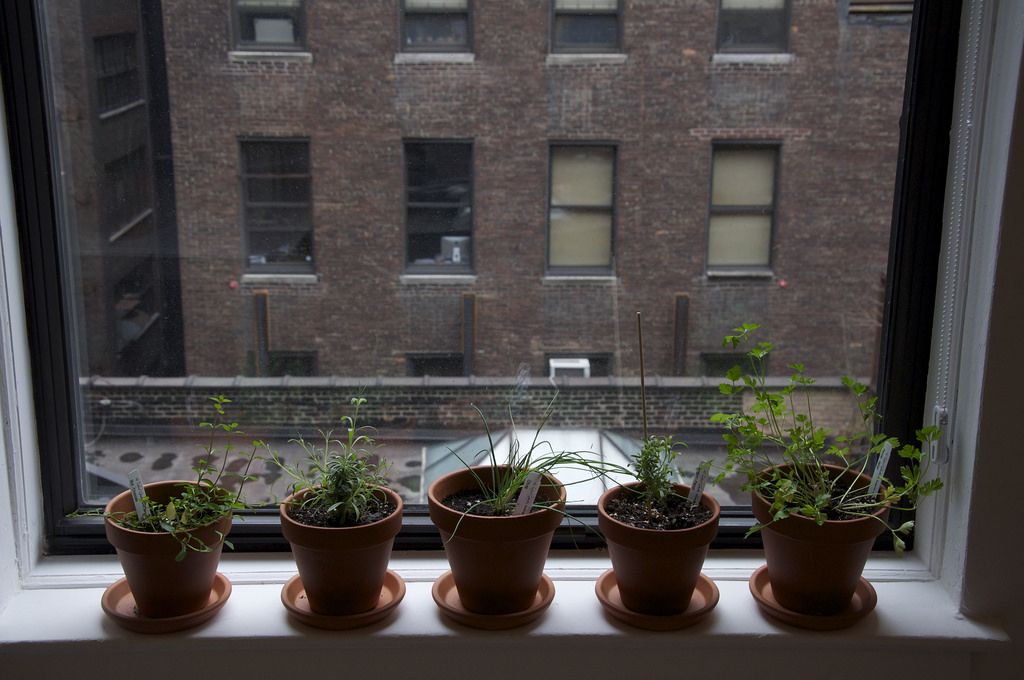
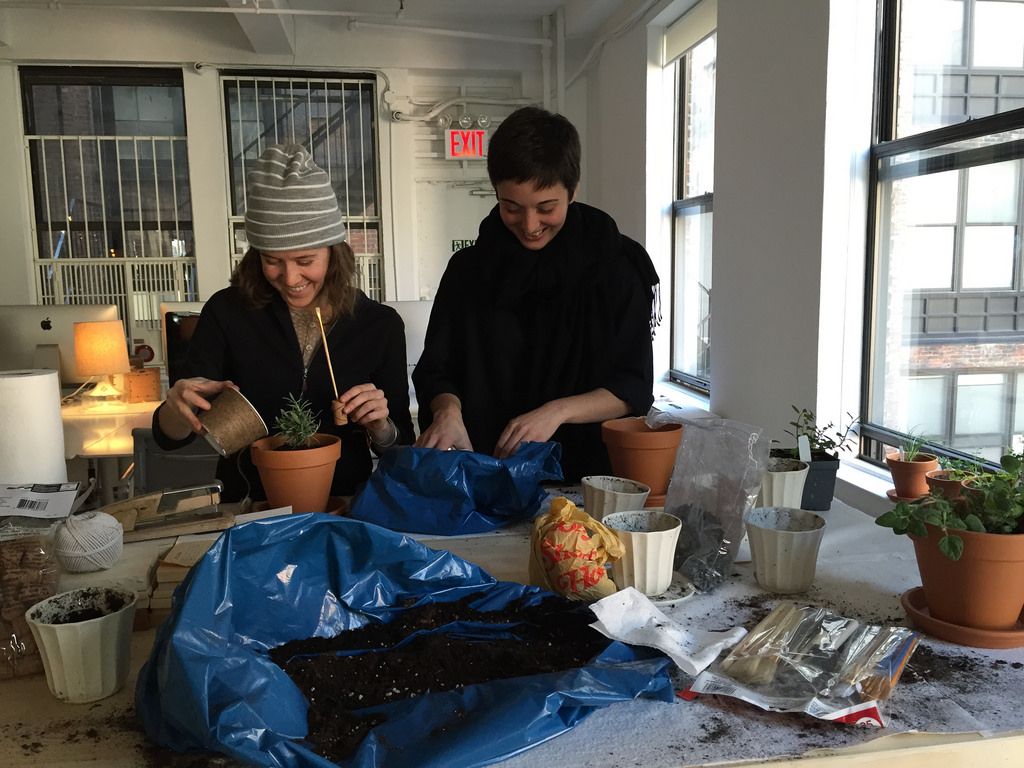

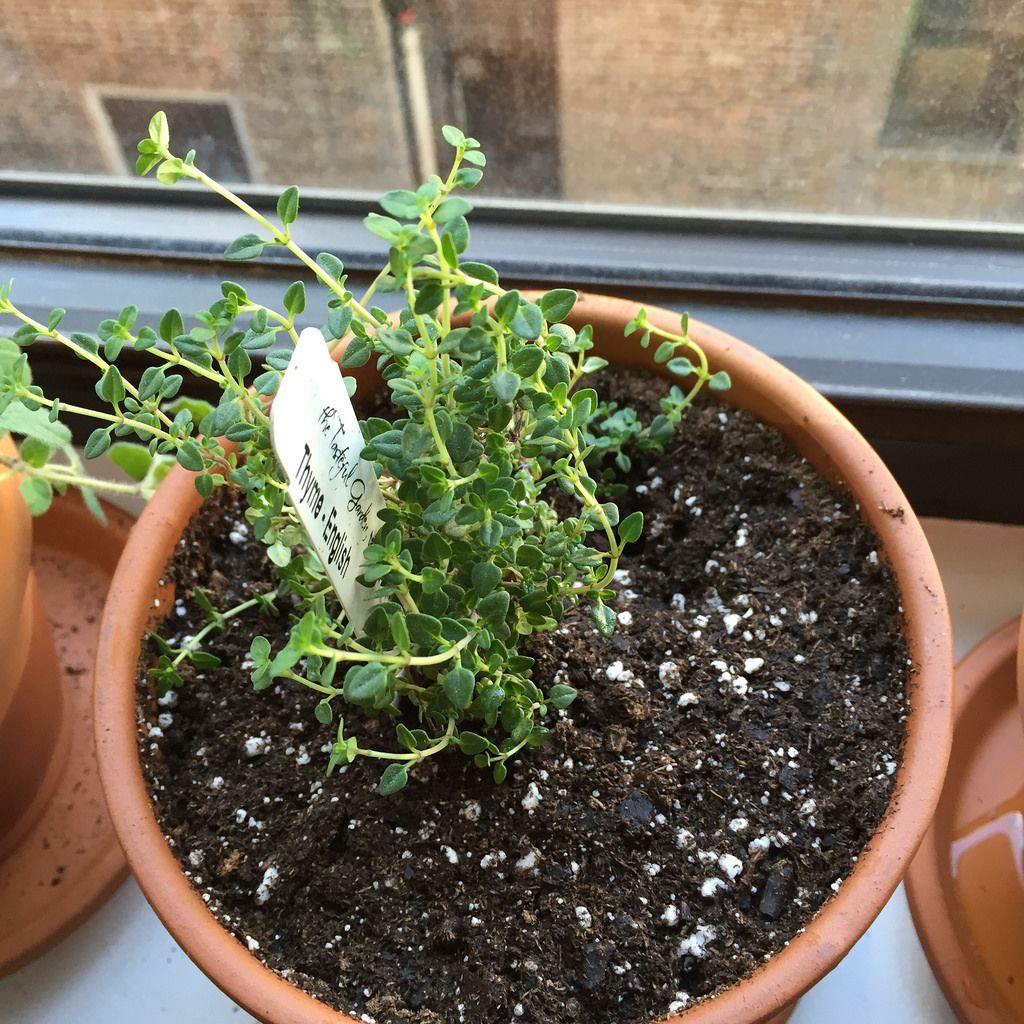
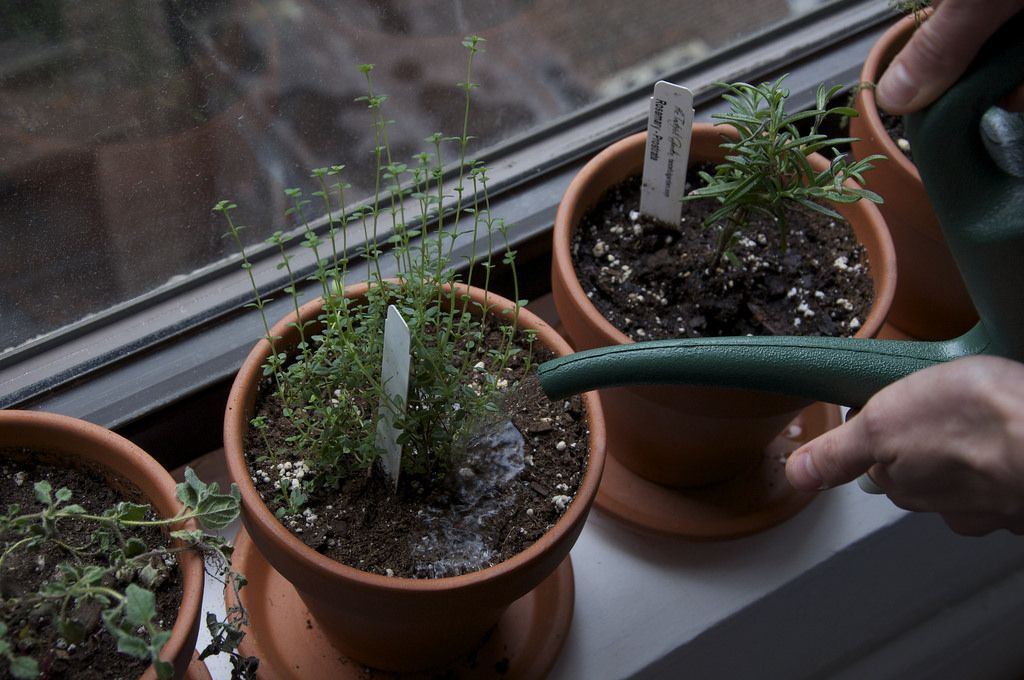
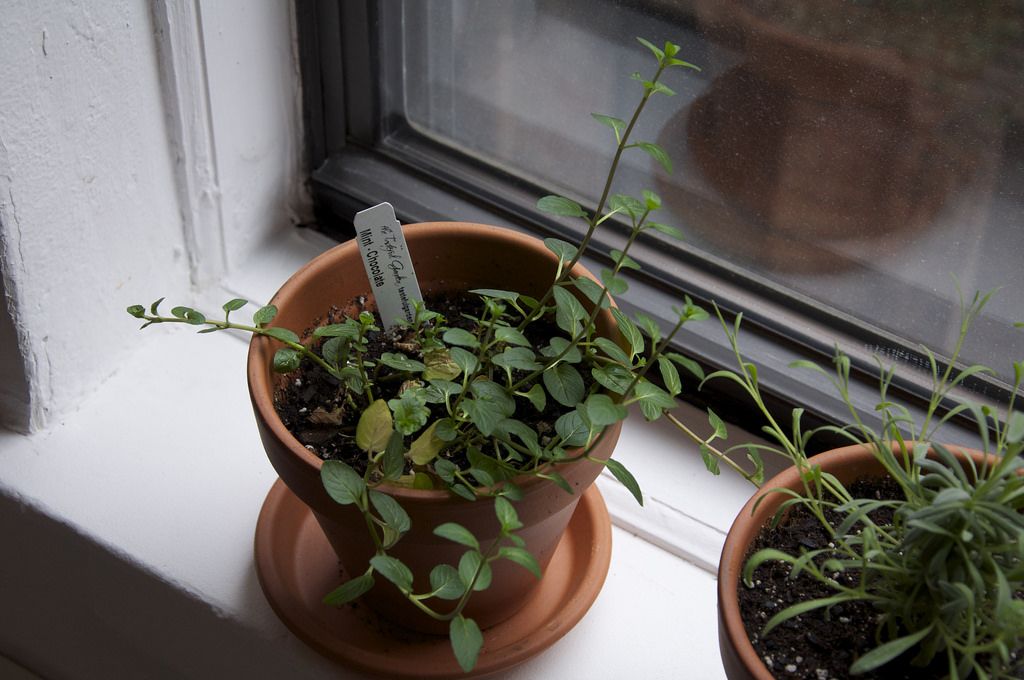 Chocolate mint
Chocolate mint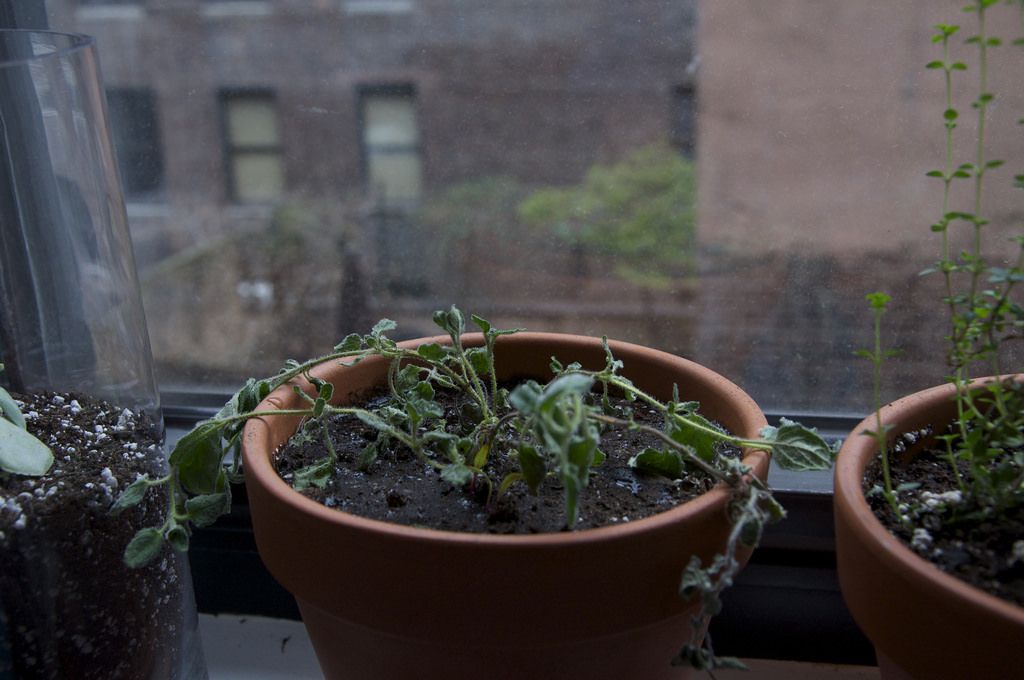
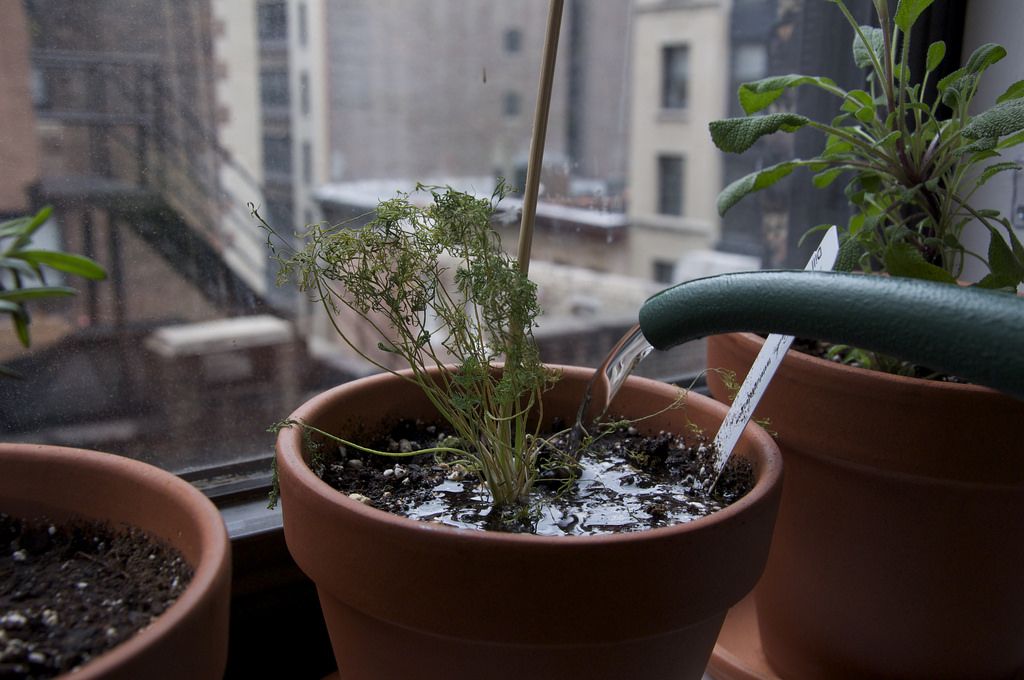
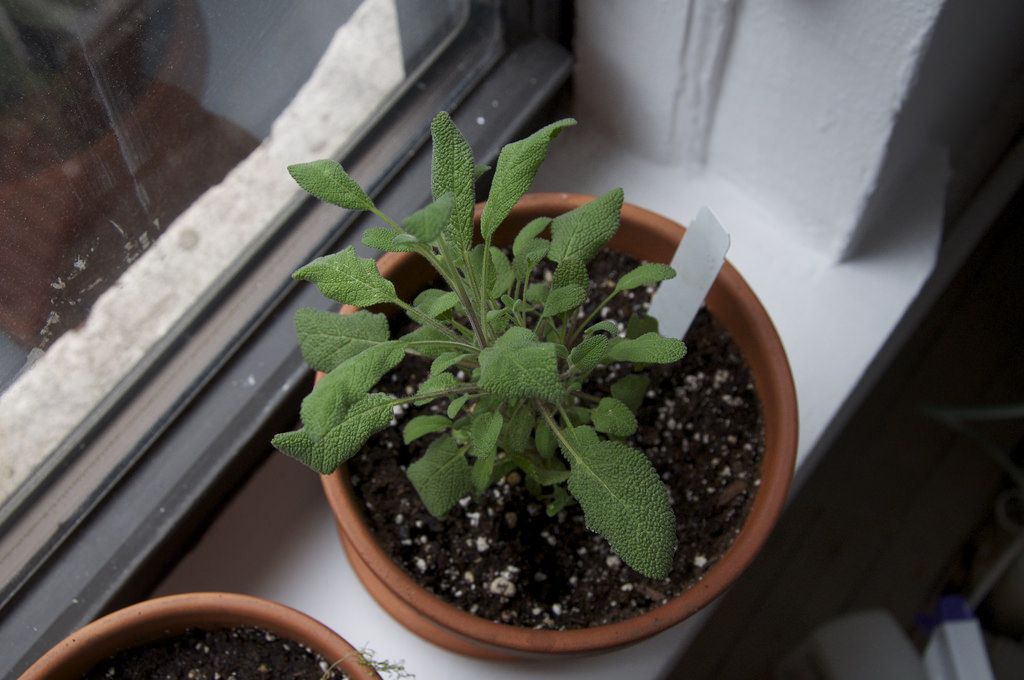 Fragile sage
Fragile sage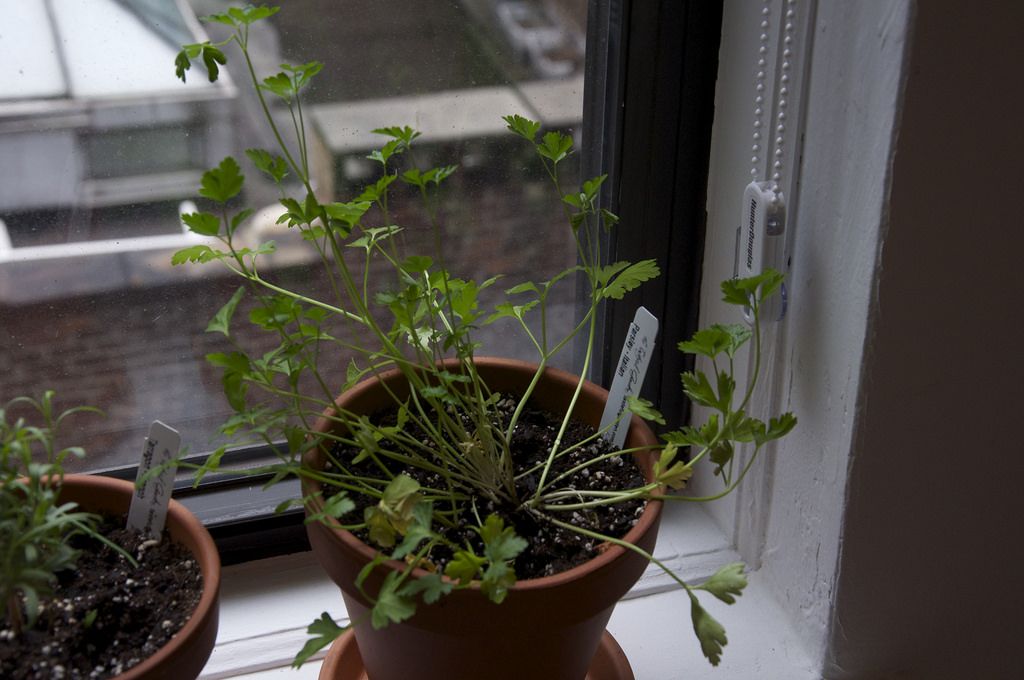
 Parsley, left, and chives and tarragon, right
Parsley, left, and chives and tarragon, right
See what other Food52 readers are saying.